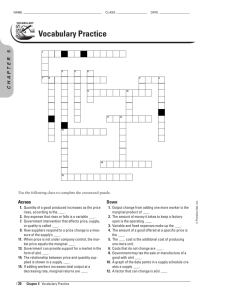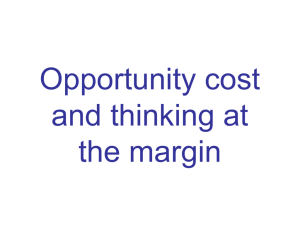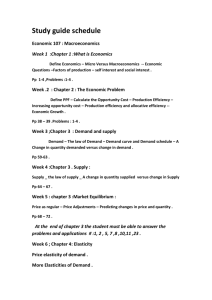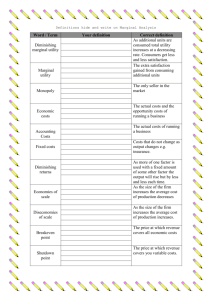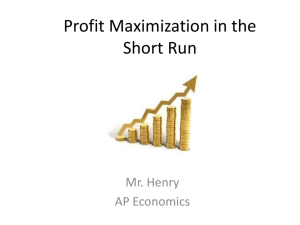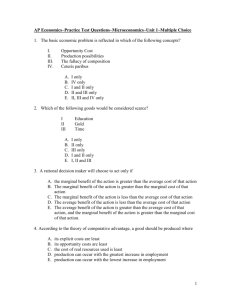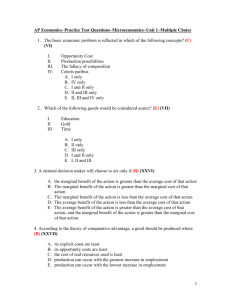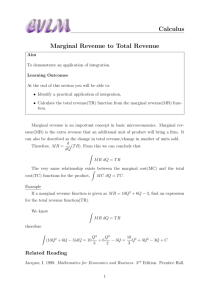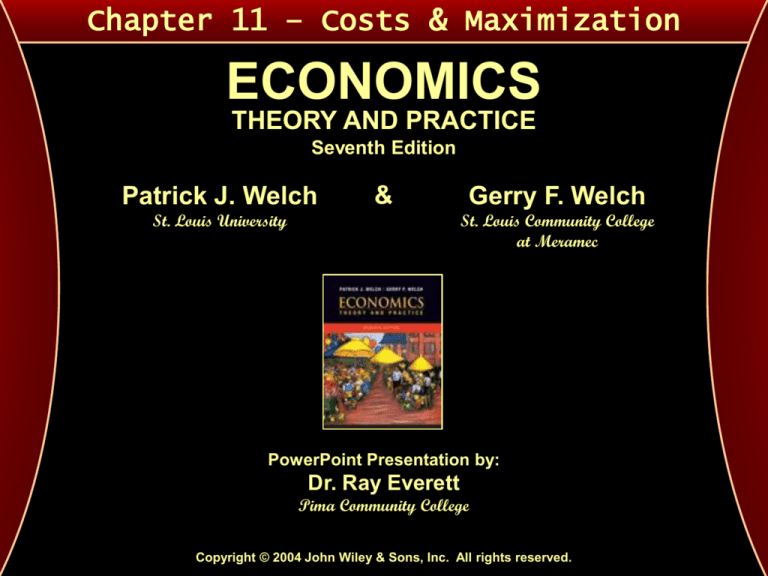
Chapter 11 – Costs & Maximization
ECONOMICS
THEORY AND PRACTICE
Seventh Edition
Patrick J. Welch
&
St. Louis University
Gerry F. Welch
St. Louis Community College
at Meramec
PowerPoint Presentation by:
Dr. Ray Everett
Pima Community College
Copyright © 2004 John Wiley & Sons, Inc. All rights reserved.
Benefits, Costs, & Maximization
Contents
Benefits & Costs: Individual
Benefits & Costs: Business
Social Benefits & Costs
Public Choice
Benefits, Costs, & Maximization
Chapter Objectives
• To explain the basic process of balancing costs and benefits in
economic decision making.
• To introduce marginal analysis, and to define marginal benefit and
marginal cost and explain their relationship to total benefit and total
cost.
• To explain how individuals measure the costs and benefits of actions,
and to introduce the Law of Diminishing Marginal Utility.
• To explain the measurement of business costs, revenues, and profit,
and to differentiate between normal and economic profit.
• To identify the rules for maximizing satisfaction by individuals and
maximizing profit by businesses.
• To introduce the concepts of externalities and social costs and
benefits.
• To examine how individual costs and benefits form the basis of
collective or public choices.
Benefits & Costs: The Individual
• Defining Benefits & Costs
Cost-Benefit Analysis
• Weighing the costs and benefits of an action in order to
maximize the net benefit from the action.
Utility
• Satisfaction realized from the consumption of a good or
service.
Opportunity Cost
• Cost of acquiring a good or service measured in terms of
the value of the opportunity or alternative foregone.
• Everything one does has an opportunity foregone
(Opportunity Costs)
11-1a
Benefits & Costs: The Individual
• Defining Benefits & Costs (cont.)
TABLE 11-1
Ranking Satisfaction
11-1b
Benefits & Costs: The Individual
• Measuring Benefits & Costs
Marginal Benefit
• Also called marginal utility.
• Change in total satisfaction from consuming an additional
unit of a good, service, or activity.
Total Benefit
• Also called total utility.
• Total amount of satisfaction received from consuming a
specified number of units of a good, service, or activity.
Law of Diminishing Marginal Utility
• As additional units of an item are consumed, beyond some
point each successive unit of the item consumed will add
less to total utility than was added by the unit consumed
just before it.
11-1c
Benefits & Costs: The Individual
• Measuring Benefits & Costs (cont.)
TABLE 11-2
Utility Points from Attending a Concert
11-1d
Benefits & Costs: The Individual
• Measuring Benefits & Costs (cont.)
Total Cost
• Cost of producing a specified number of units of a good,
service, or activity.
Marginal Cost
• Change in total cost from each additional unit of a good,
service, or activity produced.
11-1e
Benefits & Costs: The Individual
• Measuring Benefits & Costs (cont.)
TABLE 11-3
Total and Marginal Costs of Attending a Concert
11-1f
Benefits & Costs: The Individual
• Maximizing Satisfaction
Net Benefit
• That which results when total cost is subtracted from total
benefit.
Net Benefit Maximizing Rules
• Net benefit is maximized where total benefit exceeds total
cost by the greatest amount, or where marginal benefit
equals marginal cost.
– Net benefit increases as long as marginal benefit is
greater than marginal cost, no matter how small the
difference.
– Net benefit decreases when marginal cost becomes
greater than marginal benefit because more is subtracted
than is added to satisfaction.
11-1g
Benefits & Costs: The Individual
• Maximizing Satisfaction (cont.)
TABLE 11-4
Benefits and Costs of Attending a Concert
11-1h
Benefits & Costs: The Individual
• Graphing Costs, Benefits, and Net Benefit
FIGURE 11-1
Total Cost and Benefit, Marginal Cost and Benefit, and Net Benefit
11-1i
Benefits & Costs: The Individual
• Graphing Costs, Benefits, and Net Benefit
FIGURE 11-1
(continued)
11-1j
Benefits & Costs: The Business
• Defining Benefits & Costs
Explicit Costs
• Payments that a business makes to acquire factors of
production, such as labor, raw materials, and machinery.
Implicit Costs
• Opportunity costs to business owners from using their
resources in the business rather than in an alternative
opportunity.
Normal Profit
• Profit necessary to recover implicit costs and keep a
business in operation.
Economic Cost of Production
• Includes all explicit and implicit costs of producing a good
or service.
Excess Profit
• Also called economic profit.
• Profit beyond normal profit.
11-2a
Benefits & Costs: The Business
• Measuring Revenues and Costs
Total Revenue
• Revenue received from selling a certain quantity of an item.
– Calculated by multiplying the price of an item by the
quantity demanded at that price.
Marginal revenue
• Change in total revenue when one more unit of an item is
demanded.
11-2b
Benefits & Costs: The Business
• Measuring Revenues and Costs (cont.)
TABLE 11-5
Revenues from Selling Chairs
11-2c
Benefits & Costs: The Business
• Measuring Revenues and Costs (cont.)
TABLE 11-6
Costs of Producing Chairs
11-2d
Benefits & Costs: The Business
• Maximizing Profit
Profit or Loss
• Result when a business subtracts its total cost from its total
revenue.
Profit Maximizing Rules
• Profit is maximized at the output level where total revenue
exceeds total cost by the greatest amount, or where
marginal revenue equals marginal cost.
11-2e
Benefits & Costs: The Business
• Maximizing Profit (cont.)
TABLE 11-7
Revenues, Costs, and Profit on Chairs
11-2f
Benefits & Costs: The Business
• Graphing Costs, Revenues, and Profit
FIGURE 11-2
Total Revenue and Cost, Marginal
Revenue and Cost, and Profit
11-2g
Benefits & Costs: The Business
• Graphing Costs, Revenues, and Profit
FIGURE 11-2
(continued)
11-2h
Social Benefits & Costs
• Social Benefits & Costs Overview
Externality
• Effect of an action on a person or thing that was not one of
the primary parties to the action.
• Positive Externality
– Externality that creates a benefit for others.
• Negative Externality
– Externality that creates a cost for others.
• Maximizing Society’s Net Benefit
Social Benefits & Costs
• Total effect of society from the private benefits, private
costs, and externalities of an action.
– Private benefits + positive externalities = social benefits
– Private costs + negative externalities = social costs
– Social benefits – social costs = net benefit to society
11-3a
Social Benefits & Costs
• Maximizing Society’s Net Benefit (cont.)
Relationship between private and social net benefits
• When production generates negative externalities, society’s
net benefit is maximized by cutting back on the output level,
and vice versa.
FIGURE 11-3
Maximizing Social Net Benefit with Negative and Positive Externalities
11-3b
Public Choice
• Public Choice
Study of economic motives and attitudes of voters and
public officials in collective decision making.
• Maximizing Behavior and the Voting Process
A person’s decision about whether or not to vote in an
election depends on his or her marginal benefit and
marginal cost of voting.
Rational Ignorance
• Choosing to remain uninformed because the marginal cost
of obtaining the information is higher than the marginal
benefit from knowing it.
Special Interest Group
• People who share a common position on a particular issue
and actively promote that position.
11-4
Chapter 11 – Costs & Maximization
This is the end of Chapter 11.
To return to the contents menu of this
chapter, click on the menu graphic to the
right of this text.
To begin Chapter 12, click on the next
chapter icon to the right of this text.
Menu
Next
Chapter
ECONOMICS
THEORY AND PRACTICE
Seventh Edition
Copyright © 2004 John Wiley & Sons, Inc. All rights reserved. Reproduction or translation of this work
beyond that permitted in Section 117 of the 1976 United States Copyright Act without the expressed
written permission of the copyright owner is unlawful. Request for further information should be
addressed to the Permissions Department, John Wiley & Sons, Inc. The purchaser may make back-up
copies for his/her own use only and not for distribution or resale. The Publisher assumes no
responsibility for errors, omissions, or damages, caused by the use of these programs or from the use
of the information contained herein.

